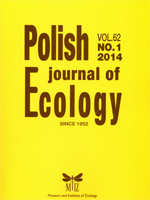The aim of this study was to assess the density and diet composition of freeranging dogs in Poland. The study was conducted in a field and forest mosaic in the central part of the country in the years 2005–2011. The density of the free-ranging dogs was assessed during night counts along repeated transect routes. The number of dogs seen and the feasible observation area were recorded to calculate density index for each control. The day and night counts captured data on group composition and penetration range. Diets were studied through scat analyses. The dog density ranged from 2.2–3.1 ind. km-2 depending on the area. Most dogs were observed alone, and 40% formed groups of 2 to 5 dogs. Most groups were recorded close to buildings, but the group organisation changed (especially during the daytime) with increasing distance from the buildings: 35% of dogs in the village were in groups, but 55% of dogs formed groups at a distance of more than 100 m from the buildings. The night proportion of dogs in groups was approximately 50%, regardless of the distance. Their scats contained mostly cereal given by farmers. The prey remains were game species: roe deer (1.3% of occurrences in summer and 12% in winter), brown hare (3–4%), small mammals (5–9.5%) and birds (approx. 1.5%). The study demonstrated that the abundance of dogs in the rural areas of central Poland may play an important role in the ecosystem.
How to translate text using browser tools
1 March 2014
Free-Ranging Domestic Dogs (Canis familiaris) in Central Poland: Density, Penetration Range and Diet Composition
Dagny Krauze-Gryz,
Jakub Gryz
ACCESS THE FULL ARTICLE
<
Previous Article
|

Polish Journal of Ecology
Vol. 62 • No. 1
March 2014
Vol. 62 • No. 1
March 2014
distances from buildings
group composition
habitat exploration
predation
rural areas




